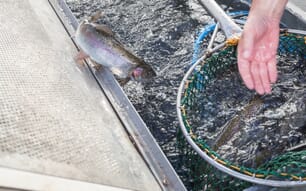The researchers examined five pesticides used to kill sea lice (Lepeophtheirus salmonis) and showed that in many cases their concentrations exceeded UK EQSs.
They used UK standards, they explain, because there are currently no Norwegian EQSs for these chemicals, and call for international quality standards to be drawn up.
Sea lice are a major problem in aquaculture, as they can seriously damage or even kill farmed fish such as salmon and cod. To control infestations, managers treat the fish with veterinary pesticides.
However, there are concerns these may harm other marine wildlife susceptible to these toxic chemicals.
In this study, the researchers investigated the levels of antiparasitic medicines found in the sea near five salmon or cod fish farms in Norway, one of Europe’s leading producers of farmed fish.
The researchers collected sediment and water samples, as well as blue mussels (Mytilus edulis), shrimp-like amphipods (Gammarus locusta), shrimp (Pandalus borealis), brown crab (Cancer pagurus) and cod (Gadus morhua) from around the five farms.
They screened the samples for five antiparasitic compounds: diflubenzuron, teflubenzuron, emamectin benzoate, cypermethrin and deltamethrin, depending on which products the farms had used.
They compared their measurements with UK environmental quality standards (EQS) – thresholds set to protect the environment and human health – as Norway has no EQSs for the five lice treatments.
The results showed that concentrations of diflubenzuron in the water near farms using the pesticide were above the EQS of 5 ng/L (nanograms per litre). The researchers used risk quotients (the actual measured environmental concentration divided by EQS) as an indicator of the risk of adverse environmental effects. In 40 per cent of the water samples, diflubenzuron risk quotients were greater than one, indicating potential risk to non-target marine wildlife.
At a farm using teflubenzuron, concentrations in water samples were above the EQS of 6 ng/L and those in sediment samples were above the EQS of 2 ng/L. The risk quotients for this pesticide were greater than one in 67 per cent of the sediment samples.
Diflubenzuron and teflubenzuron were also detected in crab, shrimp and blue mussels taken from the selected sites. Although the researchers could not determine how this affected the individuals, it does suggest that these pesticides can be taken up by wildlife. This is of particular concern for these creatures, the researchers say, because these chemicals work by interfering with shell formation.
Emamectin benzoate sediment concentrations were higher than the EQS of 0.763 ng/L in half of the samples tested. Levels of this pesticide were below the limits of detection in blue mussel or water samples. Both cypermethrin and deltamethrin were below the limit of detection in all of the samples the researchers analysed.
The researchers highlight the need for international EQSs and say that the lack of monitoring and toxicity data makes it difficult to determine just how much of a risk these pesticides are to the marine environment.
Source: Langford, K.H., Øxnevad, S., Schøyen, M., Thomas, K.V. (2014) Do Antiparasitic Medicines Used in Aquaculture Pose a Risk to the Norwegian Aquatic Environment? Environmental Science &Technology. DOI:10.1021/es5005329




